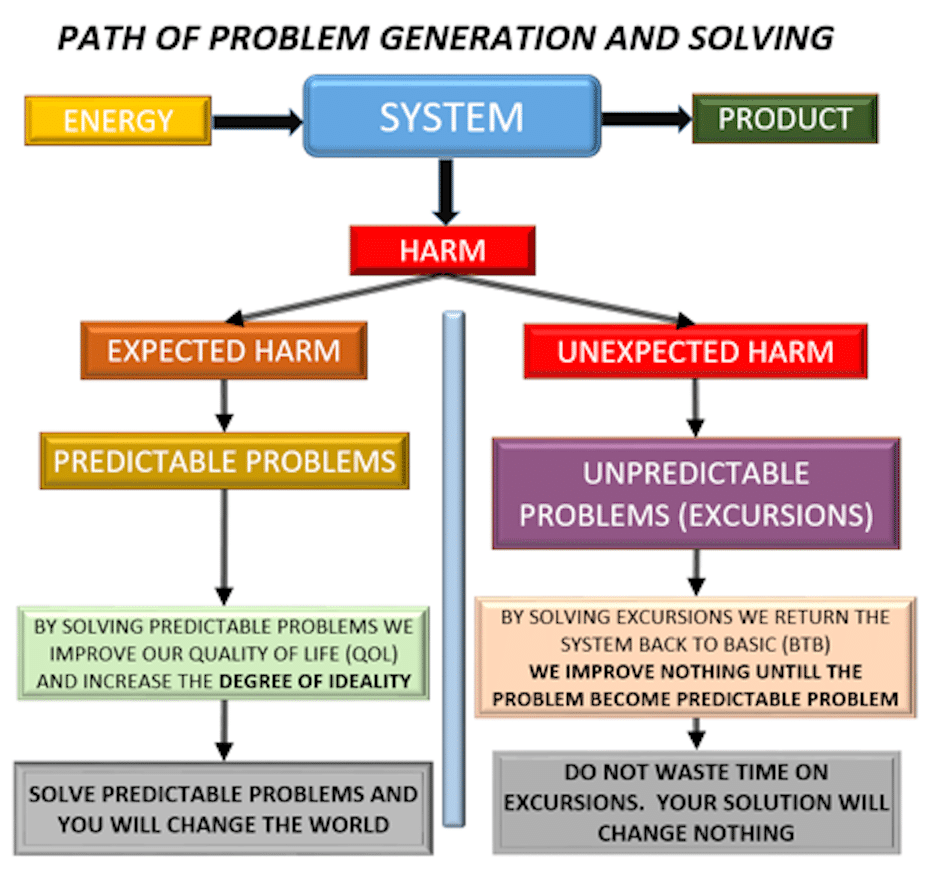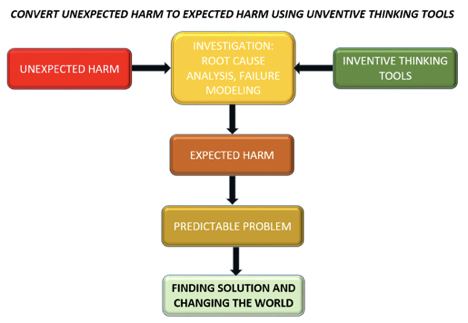In the world of problem-solving, understanding the root cause is paramount. “What generates a problem?” is a fundamental question that leads us to explore the nature of problems and their origins. We are all problem solvers, encountering challenges daily. Yet, whether we innovate or invent, the essence lies in effectively solving the problem at hand. A patent, for instance, serves as documented proof of problem resolution. This article delves into the complexities of problem generation, distinguishing between expected and unexpected harm, and emphasizes the importance of converting unexpected harm into predictable problems. Understanding the nature of problems, their sources, and effective problem-solving strategies is key to advancing technology and improving our lives.
Where do problems come from? Did you try to understand their origin when you were met with them? Let’s start from the beginning, from ideality. The ideality equation formulated by Genrich Altshuller in the form of the law states: “The development of all systems proceeds in the direction of the increase of the degree of ideality” (There are many references regarding ideality on the Internet. For instance: Simplified TRIZ, CRC Press 2008, p.77)
Generally, this term means that systems evolve in the direction of their simplification. The vector of a system developing directs us into the reduction of the amount of the components. Each time we remove some parts from the system, we take a step forward, while each time we add something to the system we step backward. The equation of the Ideality is typically described as follows:

The equation indicates directions for Ideality increase: “Harm” and “Cost” should be reduced whereas “Benefits” should be increased. However, we all already know that in order to change something we need to solve the relevant problem. What is the source of the problem? It could be reasonable to suppose that the source of a problem is where the flaw can be found. “Flaw” is a factor that is opposite to the Ideality:

Actually, a system consumes “Cost” that also could be expressed as “Energy”. “Benefit” is a desired result of the system activity; therefore, the parameter “Benefit” could be replaced for “Product”. A “Product” is an item or service that the system is created for. Nevertheless, at the same time, a system produces “Harm” as well because the system is not ideal. “Product” is a desired output of the system activity while “Harm” is an undesired output of the system. A “Harm” appears because of a system flaw and becomes the source of the problem generator.
Discover: Help the AI Assistant to help you – define the project context

Let’s describe the chart. Again, “System” consumes “Energy” and converts it into the “Product.” At the same time, the system converts a part of the energy into ”Harm”.
“Harm” is a source of problems. There are two types of harm: expected harm and unexpected harm.
Expected “Harm” means the flaw, an undesired output that we are aware of and knew existed from the beginning. For instance, we buy an expensive luxury car, but we are aware that the engine, transmission parts, and tires will wear with time and will eventually need to be replaced. We build a house that’s comfortable and beautiful, but we know that the plaster and paint will crack and fade with time. We agree to start a high-volume manufacturing initiative even if the output yield is less than 100% and even less than initially desired, and so on. One begins to understand and can continue the list.
Such expected harm generates a set of predictable problems – the problems that we are all very familiar with. The examples of predictable problems are as follows: the car should be brought to a car workshop after certain mileage to perform technical service; the walls of the house should be repaired after several years; the cost of the product will be increased due to reduced output yield.
Such problems cause inconvenience in our lives, but we knowingly agreed to face them. We even made them slightly comfortable by the fact that these are predictable problems -we know they’re coming.
All predictable problems can and should be solved. Solutions of the predictable problems, as discussed above, will result in an increase of car mileage to service, the period of time between repairing of walls in the house, the yield of the product that is produced at high volume manufacturing.
Solutions of predictable problems typically refer to fundamental changes in the system. They improve the system, make the system reduce the amount of “Harm” and to increase the degree of ideality. By solving predictable problems, we develop the system, push technology forward, but we also improve our lives and improve the quality of life (QOL).
Solve predictable problems if you want to change the world.

Unexpected “Harm” is the second type of Harm produced by a system. In these cases, we were not aware and not previously agree to handle the subsequent situation. More than that, we typically completely disagree with this type of “Harm”. Examples could be as follows: an unknown frightening noise is heard in the car engine, a huge crack suddenly occurred in the wall of а house, the output yield of the product at high-volume manufacturing unpredictably dropped.
All these unexpected harms generate unpredictable behavior; they are spontaneous deviations from the norms we’ve been told or taught to expect. We definitely need to solve the issues, however: we should bring the car to a professional car workshop for diagnosis and repair; we should invite building specialists to fix the cracked wall and find a way to recover the output yield that suddenly dropped. By solving of unpredictable problems, we never move forward or progress; we just return the situation back to basic (BTB). Even if we find an excellent solution to the unpredictable problems, the system will not be transformed and its design will not be improved.
Do not spend too much time solving unpredictable problems (excursions), because this is not the way to change the world.
Even when unexpected problems arise, not everything is lost: unpredictable problems can be converted into predictable problems. Solving predictable problems will allow us to change the world. The process chart of the conversion is shown below:

You might be interested: Enhanced AI Assistant: Revolutionizing Information Access
Prior to touching the problem, you should start with HARM, to convert Unexpected Harm to Expected Harm. This is not an easy operation at all. This is an investigation that can be successfully completed only with the help of Inventive Thinking Tools. These tools will help you to define the root cause of the failure, create a model of the failure and to understand the mechanism of the sudden unexpected harm occurrence. The Inventive Thinking Tools will make you think “out of the box” and understand something that you were unable to understand before. When the precise nature of the harm becomes clear, the unexpected harm (excursion) is automatically converted to expected harm that generates predictable problems.

Moreover, as you already know that by solving predictable problems, you can improve our quality of life and change the world. For instance, investigate and understand why the engine of your car became noisy and invent a solution in order to prevent such failure in the future. Investigate and understand why the wall of your house got cracked and prevent it. Investigate and understand which parameter of the high-volume manufacturing process is impacting the output yield and use it as a strong tool for increasing the product output yield.
Solve predictable problems, improve QOL and change the world.
Cdr Vinod Dahake
June 24, 2020
Good to read. Harmful effects needs to be curbed or neutralized
vinod
August 12, 2020
every problem is unpredictable, till the root cause is not found. Once the root cause is found, it is no more an unpredictable problem.
In my opinion, most of the problem in production arises because of many parameters which affect the process are not well understood.
S.B
August 29, 2020
Good read thank you for sharing
Juan Perez-Camacho
November 25, 2020
Hi Anatoly, I really like your logic here. Inverting the Ideality equation is a great insight! And converting unexpected harm into expected harm is a good description of the root cause analysis process. Thanks for sharing! Regards, Juan